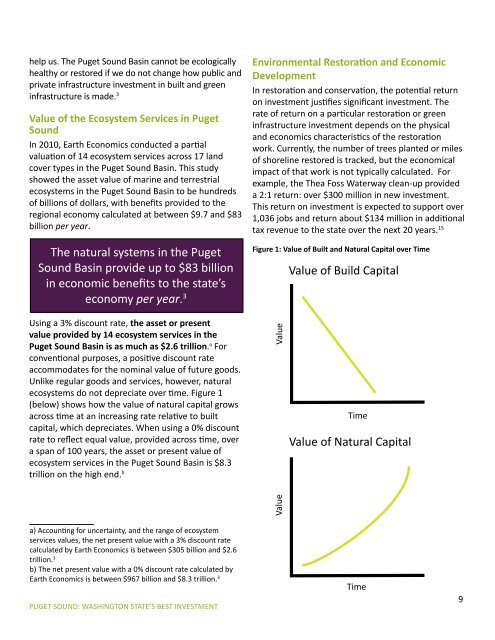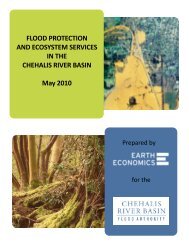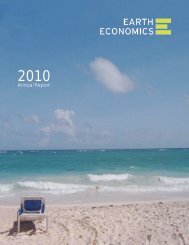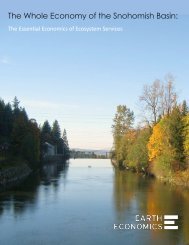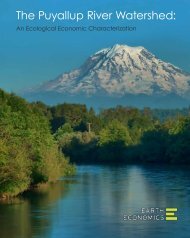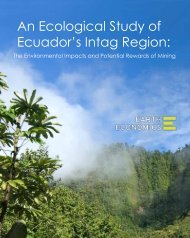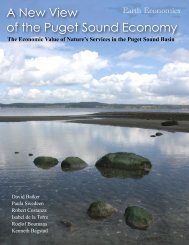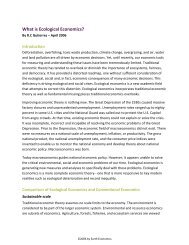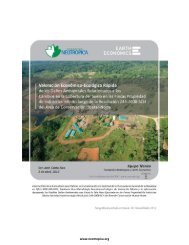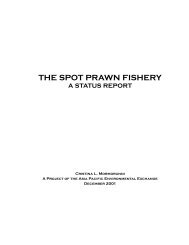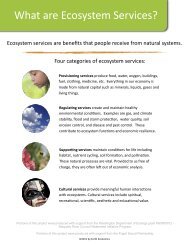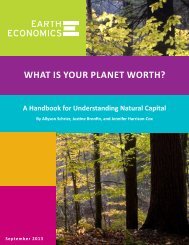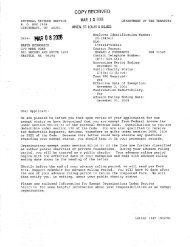Puget Sound: Washington State's Best Investment - Earth Economics
Puget Sound: Washington State's Best Investment - Earth Economics
Puget Sound: Washington State's Best Investment - Earth Economics
Create successful ePaper yourself
Turn your PDF publications into a flip-book with our unique Google optimized e-Paper software.
help us. The <strong>Puget</strong> <strong>Sound</strong> Basin cannot be ecologically<br />
healthy or restored if we do not change how public and<br />
private infrastructure investment in built and green<br />
infrastructure is made. 3<br />
Value of the Ecosystem Services in <strong>Puget</strong><br />
<strong>Sound</strong><br />
In 2010, <strong>Earth</strong> <strong>Economics</strong> conducted a partial<br />
valuation of 14 ecosystem services across 17 land<br />
cover types in the <strong>Puget</strong> <strong>Sound</strong> Basin. This study<br />
showed the asset value of marine and terrestrial<br />
ecosystems in the <strong>Puget</strong> <strong>Sound</strong> Basin to be hundreds<br />
of billions of dollars, with benefits provided to the<br />
regional economy calculated at between $9.7 and $83<br />
billion per year.<br />
The natural systems in the <strong>Puget</strong><br />
<strong>Sound</strong> Basin provide up to $83 billion<br />
in economic benefits to the state’s<br />
economy per year. 3<br />
Environmental Restoration and Economic<br />
Development<br />
In restoration and conservation, the potential return<br />
on investment justifies significant investment. The<br />
rate of return on a particular restoration or green<br />
infrastructure investment depends on the physical<br />
and economics characteristics of the restoration<br />
work. Currently, the number of trees planted or miles<br />
of shoreline restored is tracked, but the economical<br />
impact of that work is not typically calculated. For<br />
example, the Thea Foss Waterway clean-up provided<br />
a 2:1 return: over $300 million in new investment.<br />
This return on investment is expected to support over<br />
1,036 jobs and return about $134 million in additional<br />
tax revenue to the state over the next 20 years. 15<br />
Figure 1: Value of Built and Natural Capital over Time<br />
Value of Build Capital<br />
Using a 3% discount rate, the asset or present<br />
value provided by 14 ecosystem services in the<br />
<strong>Puget</strong> <strong>Sound</strong> Basin is as much as $2.6 trillion. a For<br />
conventional purposes, a positive discount rate<br />
accommodates for the nominal value of future goods.<br />
Unlike regular goods and services, however, natural<br />
ecosystems do not depreciate over time. Figure 1<br />
(below) shows how the value of natural capital grows<br />
across time at an increasing rate relative to built<br />
capital, which depreciates. When using a 0% discount<br />
rate to reflect equal value, provided across time, over<br />
a span of 100 years, the asset or present value of<br />
ecosystem services in the <strong>Puget</strong> <strong>Sound</strong> Basin is $8.3<br />
trillion on the high end. b<br />
Value<br />
Time<br />
Value of Natural Capital<br />
Value<br />
a) Accounting for uncertainty, and the range of ecosystem<br />
services values, the net present value with a 3% discount rate<br />
calculated by <strong>Earth</strong> <strong>Economics</strong> is between $305 billion and $2.6<br />
trillion. 3<br />
b) The net present value with a 0% discount rate calculated by<br />
<strong>Earth</strong> <strong>Economics</strong> is between $967 billion and $8.3 trillion. 3<br />
PUGET SOUND: WASHINGTON STATE’S BEST INVESTMENT<br />
Time<br />
9


